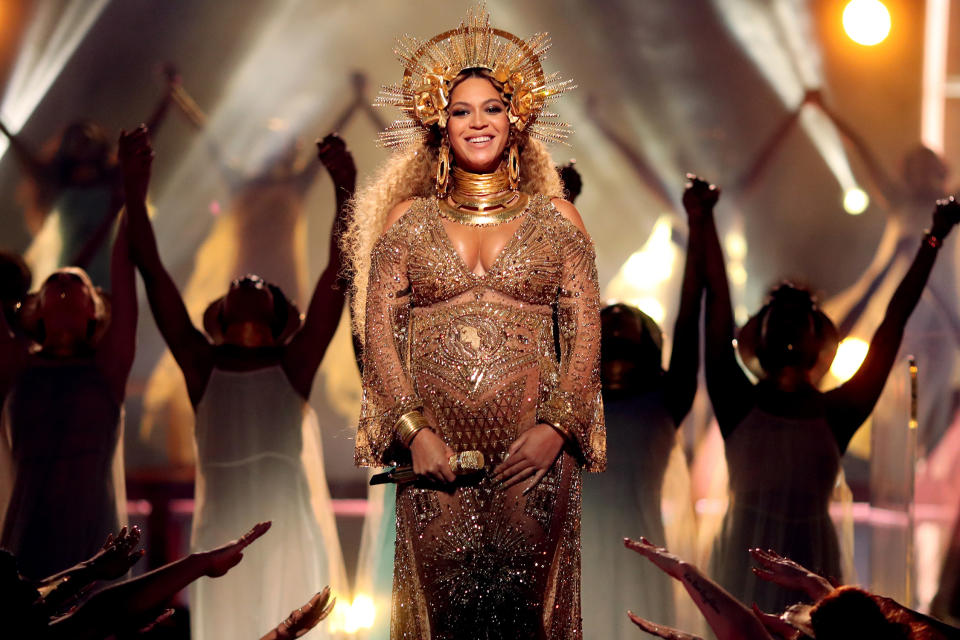What Happens When You Birth Twins? 5 Facts Amal Clooney and Beyoncé Probably Already Know
Bring on the Bey-bies!
With Beyoncé and Jay Z‘s twins due any day now, the superstar is in for a world of wonderful. But as moms of twins know, the birthing process can be very different.
In a statement George Clooney and wife Amal released this week announcing they’d welcomed twins, Ella and Alexander, the actor joked he was “sedated and should recover in a few days.” Next up on the stork’s list are the Carters. Already parents to daughter Blue Ivy, 5, Bey and Jay announced their pregnancy in February, and the singer most recently showed off her double-baby bump on Instagram for Memorial Day.
With such high-profile pregnancies in the news, it’s no wonder people have twins on the brain. But what does it take to actually bring forth a double bundle of joy? In celebration of Amal, Beyoncé, and all the other moms-of-multiples, here are five things you might not know about the birthing process for twins.
1. C-sections are common, but not mandatory
The chances that a mom-to-be of twins will need a C-section are higher than a woman who’s only having one baby, but it’s not a given. Doctors will often encourage women to try for a vaginal birth if both babies are positioned head-down, says Robyn Horsager-Boehrer, MD, professor of obstetrics and gynecology at UT Southwestern Medical Center and a mom of twins herself.
“You’re a little bit at the whim of what position that first twin is in,” says Dr. Horsager-Boehrer. If only the first baby is head-down, doctors may deliver one vaginally and then try to reposition the second one, deliver the second baby breech (feet-first), or perform an emergency C-section on the second.
2. Most twins are delivered early
Experts say the best time to deliver twins is at 37 weeks gestation, or 36 weeks if the babies share a placenta, to reduce the risk of complications for both the babies and the mother. Twin pregnancies are sometimes induced at this point or not long after, but women often go into labor early on their own.
3. Doctors will take extra precautions
“For twin births, there are going to be a lot more people in the delivery room,” says Dr. Horsager-Boehrer. A second obstetrician will likely be on hand to monitor the babies via ultrasound, to help out if a last-minute C-section is required, and to take care of the first baby while the second one is on its way.
“In addition, there will also be two teams [of nurses and assistants] for the babies, which can lead to a pretty busy room,” she adds. In fact, some hospitals will opt to deliver twins in operating rooms where there’s more space, even if a vaginal birth is planned.
Regardless if a woman delivers twins via C-section or vaginal birth, she will likely lose more blood than if she were only delivering one baby, says Dr. Horsager-Boehrer. Blood and iron loss can cause anemia, so new moms may have to take iron pills after delivery to return their iron levels to normal.
FROM PEN: Katherine Heigl Opens Up About Experiencing Her First Pregnancy
4. Twin deliveries can be minutes, hours, or even days apart
In some cases, twins are delivered vaginally within minutes of each other, and the second one isn’t usually more than an hour behind the first. (If they’re delivered via C-section, doctors will remove the babies one after the other with little time in between.)
More than an hour between deliveries is not common, says Dr. Horsager-Boehrer. “If the uterus slows down and stops contracting and the baby is headfirst, we can administer the drug pitocin to get them going,” she says, “almost like an induction of babies who are past their due date.”
Only in rare cases, like when a first twin is born very prematurely, will doctors try to delay the birth of the second twin. And in extraordinary circumstances, twins can be conceived—and born—up to 24 days apart, when a woman ovulates more than one egg in a cycle but the eggs are released at different times. (Last year an Australian woman experienced this extremely rare phenomenon, known as superfetation or interval birth.)
5. Recovery is similar, but twin moms may be more tired
Birthing twins via vaginal delivery isn’t usually any harder on the mother than birthing singleton babies, says Dr. Horsager-Boehrer. “In some ways, it might even be a little less traumatizing because twin babies tend to be born earlier and smaller,” she says. “It’s not unusual to have twins born at 4, 5, 6 pounds, whereas a larger singleton baby can cause more swelling and tears.”
New moms may notice a difference once they get their babies home, though. “Feeding two babies, especially if you’re breastfeeding, is a lot more work,” she says. “You can be up for longer periods in the night doing feedings, and you can end up being potentially more exhausted.”
Of course, we’re sure our celebrity twin mamas will have plenty of help—and get lots of love—caring for their newborns. Here’s wishing the best to the Clooneys, the Carters, and all the twin families out there!




